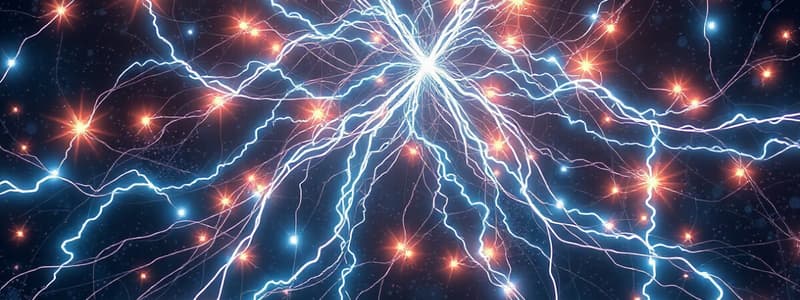Podcast
Questions and Answers
Why is electricity crucial for the operation of neural networks?
Why is electricity crucial for the operation of neural networks?
- Electricity is only necessary for training networks, not for their subsequent operation.
- Electricity is used for network cooling but not for any other part of the network's function.
- Electricity is used to power the network, but does not directly affect its computational processes.
- Electrical signals are fundamental to neural networks, enabling neuron activation, information transfer, and computation. (correct)
How do different types of neural networks impact their electrical requirements?
How do different types of neural networks impact their electrical requirements?
- The complexity and size of a neural network, along with its intended function, determine its electrical needs. (correct)
- Deep learning networks require less electricity due to their more efficient architectures.
- Networks requiring high throughput and processing power, such as those used for image recognition, typically need less electricity.
- All neural networks require the same amount of electricity regardless of their type or intended application.
What are some of the essential electrical components found in neural networks?
What are some of the essential electrical components found in neural networks?
- Transistors, capacitors, resistors, and interconnects. (correct)
- Solar panels, wind turbines, and power transformers.
- Batteries, switches, light bulbs, and wires.
- Motors, generators, and power grids.
How can energy consumption be minimized in neural networks?
How can energy consumption be minimized in neural networks?
What is a major challenge in developing large neural networks?
What is a major challenge in developing large neural networks?
What is the primary reason why specialized hardware designed for deep learning is often more energy-efficient?
What is the primary reason why specialized hardware designed for deep learning is often more energy-efficient?
Which of these can contribute to higher electricity usage in neural networks?
Which of these can contribute to higher electricity usage in neural networks?
Why are specialized hardware units like GPUs often used for deep learning tasks?
Why are specialized hardware units like GPUs often used for deep learning tasks?
Which of these statements accurately describes the relationship between electrical signals and information transmission within neural networks?
Which of these statements accurately describes the relationship between electrical signals and information transmission within neural networks?
Flashcards
Neural Networks (NNs)
Neural Networks (NNs)
Computational models inspired by the brain's structure and function.
Activation of Neurons
Activation of Neurons
Process where neurons transmit information using electrical signals.
Artificial Neural Networks (ANNs)
Artificial Neural Networks (ANNs)
Type of NNs designed for specific tasks like image recognition.
Deep Learning
Deep Learning
Signup and view all the flashcards
Electrical Components in NNs
Electrical Components in NNs
Signup and view all the flashcards
Power Consumption
Power Consumption
Signup and view all the flashcards
Specialized Hardware
Specialized Hardware
Signup and view all the flashcards
Energy Efficiency
Energy Efficiency
Signup and view all the flashcards
Energy-efficient algorithms
Energy-efficient algorithms
Signup and view all the flashcards
Electrical signals in NNs
Electrical signals in NNs
Signup and view all the flashcards
Hardware platforms for NNs
Hardware platforms for NNs
Signup and view all the flashcards
Training NNs
Training NNs
Signup and view all the flashcards
Voltage and current role
Voltage and current role
Signup and view all the flashcards
Circuit design advancements
Circuit design advancements
Signup and view all the flashcards
Quantum computing's potential
Quantum computing's potential
Signup and view all the flashcards
Power management techniques
Power management techniques
Signup and view all the flashcards
Study Notes
Introduction to NN and Electricity
- Neural networks (NNs) are computational models inspired by the structure and function of the human brain.
- They consist of interconnected nodes (neurons) organized in layers.
- Electricity plays a vital role in powering and enabling the operation of these networks, both in hardware implementations and in the training process.
- The activation of neurons, the transfer of information, and the computation itself are all driven by electrical signals.
Types of Neural Networks and their Electrical Requirements
- Different types of NNs have varying electrical requirements based on their architecture and intended applications.
- Artificial neural networks (ANNs) used for image recognition often require higher throughput and processing power, demanding more sophisticated electrical infrastructures.
- Deep learning, involving multiple layers of neural networks, can require high-performance GPUs with specialized circuits and advanced cooling, consuming substantial electricity during operation.
- Analog hardware implementations necessitate different electrical design approaches compared to digital ones.
Electrical Components in Neural Networks
- Transistors, capacitors, resistors, and wires (interconnects) are crucial electrical components in NNs.
- These manage electrical signals within the circuit and transmit electrical currents.
- Integrating these components into the network architecture significantly affects energy consumption and efficiency.
- Efficient and optimized circuit design is essential for minimizing energy usage in electrical signal processing for network communication.
Power Consumption in Neural Networks
- Training large neural networks is computationally expensive, consuming significant power.
- Power consumption ranges from hundreds to thousands of watts in high-end setups.
- Hardware type (CPUs, GPUs, ASICs) impacts power consumption.
- Specialized deep learning hardware is often more energy-efficient than general-purpose processors.
Energy Efficiency in NN Design
- Energy efficiency is a critical focus in NN research.
- There's a consistent effort to develop more energy-efficient hardware, software, algorithms, and architectures.
- Developing models with reduced parameters is part of this approach.
- Techniques to optimize algorithms and minimize calculations needed for output, as well as optimizing circuit design for energy use, are continually refined.
Electrical Signals and Information Transmission
- Electrical signals are the core method for transmitting information in NNs.
- Signal strength and timing represent the processed data.
- The flow of charge through wires and circuit elements transfers data between layers of neurons or processing units.
- Voltage and current control processing within individual processing units.
Hardware Implementation
- NNs are implemented across various hardware platforms.
- CPUs, GPUs, and application-specific integrated circuits (ASICs) are commonplace.
- Hardware choice impacts both energy efficiency and performance.
- The hardware's architecture and components directly affect electrical requirements and power consumption.
Training Process and Electricity
- Training NNs involves adjusting weights between neurons iteratively.
- This adjustment is influenced by electrical signals flowing through components, which affect neuron activation and network responses.
- Substantial electrical energy is consumed during the training computational processes.
- Efficient training algorithms and hardware are essential to minimize energy waste during training.
Future Trends and Implications
- Advancements in materials science and circuit design are expected to create more energy-efficient NN hardware.
- Quantum computing, although nascent, holds potential to drastically reduce energy consumption for specific NN calculations.
- Growing demand for NNs will drive further research in power-efficient circuit layouts, energy-saving algorithms, and innovative power management.
- Fundamental shifts in computing paradigms may reshape how neural networks interact with electricity.
Studying That Suits You
Use AI to generate personalized quizzes and flashcards to suit your learning preferences.




